Electrical Resistivity Tomography as a Support Tool for Physicochemical Properties Assessment of Near-Surface Waste Materials in a Mining Tailing Pond (El Gorguel, SE Spain)
Abstract
1. Introduction
2. Material and Methods
2.1. Study Area
2.2. Electrical Resistivity Tomography (ERT)
2.3. Sampling Collection and Geochemical Analysis
2.4. Statistical Analysis
3. Results and Discussion
3.1. Soil Properties, Metal Concentration, and ERT Imaging
3.2. ERT Model
4. Conclusions
Supplementary Materials
Author Contributions
Funding
Acknowledgments
Conflicts of Interest
References
- Thornton, I. Impacts of mining on the environment; some local, regional and global issues. Appl. Geochem. 1996, 11, 355–361. [Google Scholar] [CrossRef]
- Martín-Crespo, T.; Gómez-Ortiz, D.; Martín-Velázquez, S.; Esbrí, J.M.; De Ignacio-San José, C.; Sánchez-García, M.J.; Montoya-Montes, I.; Martín-González, F. Abandoned mine tailings in cultural itineraries: Don Quixote Route (Spain). Eng. Geol. 2015, 197, 82–93. [Google Scholar] [CrossRef]
- Gómez-Ortiz, D.; Martín-Velázquez, S.; Martín-Crespo, T.; De Ignacio-San José, C.; Lillo, J. Application of electrical resistivity tomography to the environmental characterization of abandoned massive sulphide mine ponds (Iberian Pyrite Belt, SW Spain). Near Surf. Geophys. 2010, 8, 65–74. [Google Scholar] [CrossRef]
- Kabas, S.; Faz, A.; Acosta, J.A.; Zornoza, R.; Martínez-Martínez, S.; Carmona, D.M.; Bech, J. Effect of marble waste and pig slurry on the growth of native vegetation and heavy metal mobility in a mine tailing pond. J. Geochem. Explor. 2012, 123, 69–76. [Google Scholar] [CrossRef]
- Zornoza, R.; Faz, A.; Carmona, D.M.; Martínez-Martínez, S.; Acosta, J.A. Plant cover and soil biochemical properties in a mine tailing pond five years after application of marble wastes and organic amendments. Pedosphere 2012, 22, 22–32. [Google Scholar] [CrossRef]
- Martinez-Pagan, P.; Cano, A.F.; Aracil, E.; Arocena, J.M. Electrical resistivity imaging revealed the spatial properties of mine tailing ponds in the Sierra Minera of southeast Spain. J. Environ. Eng. Geophys. 2009, 14, 63–76. [Google Scholar] [CrossRef]
- Cortada, U.; Martínez, J.; Rey, J.; Hidalgo, M.C.; Sandoval, S. Assessment of tailing pond seals using geophysical and hydrochemical techniques. Eng. Geol. 2017, 223, 59–70. [Google Scholar] [CrossRef]
- Conesa, H.M.; Faz, A.; Arnaldos, R. Initial studies for the phytostabilization of a mine tailing from the Cartagena-La Union Mining District (SE Spain). Chemosphere 2007, 66, 38–44. [Google Scholar] [CrossRef]
- Parra, A.; Faz, A.; Zornoza, R.; Conesa, E.; Gómez-López, M.D. Heavy metal accumulation and tolerance in spontaneous vegetation in El Avenque dry river bed, southeast of Spain. In Proceedings Tailings and Mine Waste; University of British Columbia: Vancouver, BC, Canada, 2012; pp. 445–450. [Google Scholar]
- Norland, M.R.; Veith, D.L. Revegetation of coarse taconite iron ore tailing using municipal solid waste compost. J. Hazard. Mater. 1995, 41, 123–134. [Google Scholar] [CrossRef]
- Acosta, J.A.; Martínez-Pagán, P.; Martínez-Martínez, S.; Faz, A.; Zornoza, R.; Carmona, D.M. Assessment of environmental risk of reclaimed mining ponds using geophysics and geochemical techniques. J. Geochem. Explor. 2014, 147, 80–90. [Google Scholar] [CrossRef]
- Martín-Crespo, T.; Gómez-Ortiz, D.; Martín-Velázquez, S.; Martínez-Pagán, P.; De Ignacio, C.; Lillo, J.; Faz, A. Geoenvironmental characterization of unstable abandoned mine tailings combining geophysical and geochemical methods (Cartagena-La Union district, Spain). Eng. Geol. 2018, 232, 135–146. [Google Scholar] [CrossRef]
- Loke, M.H.; Chambers, J.E.; Rucker, D.F.; Kuras, O.; Wilkinson, P.B. Recent developments in the direct-current geoelectrical imaging method. J. Appl. Geophys. 2013, 95, 135–156. [Google Scholar] [CrossRef]
- Reynolds, J.M. An Introduction to Applied and Environmental Geophysics; Wiley-Blackwell: Chichester, UK, 2011. [Google Scholar]
- Rucker, D.F.; Loke, M.H.; Levitt, M.T.; Noonan, G.E. Electrical-resistivity characterization of an industrial site using long electrodes. Geophysics 2010, 75, 95–104. [Google Scholar] [CrossRef]
- Rosales, R.M.; Martinez-Pagan, P.; Faz, A.; Monero-Cornejo, J. Environmental monitoring using electrical resistivity tomography (ERT) in the subsoil of three former petrol stations in SE of Spain. Water Air Soil Pollut. 2012, 223, 3757–3773. [Google Scholar] [CrossRef]
- Rosales, R.M.; Martínez-Pagán, P.; Faz, A.; Bech, J. Study of subsoil in former petrol stations in SE of Spain: Physicochemical characterization and hydrocarbon contamination assessment. J. Geochem. Explor. 2014, 147, 306–320. [Google Scholar] [CrossRef]
- Martín-Crespo, T.; Gómez-Ortiz, D.; Martínez-Pagán, P.; De Ignacio-San José, C.; Martín-Velázquez, S.; Lillo, J.; Faz, A. Geoenvironmental characterization of riverbeds affected by mine tailings in the Mazarrón district (Spain). J. Geochem. Explor. 2012, 119–120, 6–16. [Google Scholar]
- Vásconez-Maza, M.D.; Martínez-Segura, M.A.; Bueso, M.C.; Faz, Á.; García-Nieto, M.C.; Gabarrón, M.; Acosta, J.A. Predicting spatial distribution of heavy metals in an abandoned phosphogypsum pond combining geochemistry, electrical resistivity tomography and statistical methods. J. Hazard. Mater. 2019, 374, 392–400. [Google Scholar] [CrossRef]
- Page, L.M. Use of the electrical resistivity method for investigating geologic and hydrologic conditions in Santa Clara County, California. Groundwater 1968, 6, 31–40. [Google Scholar] [CrossRef]
- Wilson, S.R.; Ingham, M.; McConchie, J.A. The applicability of earth resistivity methods for saline interface definition. J. Hydrol. 2006, 316, 301–312. [Google Scholar] [CrossRef]
- Griffiths, D.H.; Barker, R.D. Electrical imaging in archaeology. J. Archaeol. Sci. 1994, 21, 153–158. [Google Scholar] [CrossRef]
- Simyrdanis, K.; Papadopoulos, N.; Kim, J.-H.; Tsourlos, P.; Moffat, I. Archaeological investigations in the shallow seawater environment with electrical resistivity tomography. Near Surf. Geophys. 2015, 13, 601–611. [Google Scholar] [CrossRef]
- White, R.M.S.; Collins, S.; Denne, R.; Hee, R.; Brown, P. A new survey design for 3D IP inversion modelling at Copper Hill. Explor. Geophys. 2001, 32, 152–155. [Google Scholar] [CrossRef]
- Bauman, P. 2-D resistivity surveying for hydrocarbons—A primer. CSEG Rec. 2005, 30, 25–33. [Google Scholar]
- Legault, J.M.; Carriere, D.; Petrie, L. Synthetic model testing and distributed acquisition dc resistivity results over an unconformity uranium target from the Athabasca Basin, northern Saskatchewan. Lead. Edge 2008, 27, 46–51. [Google Scholar] [CrossRef]
- Linderholm, P.; Marescot, L.; Loke, M.H.; Renaud, P. Cell culture imaging using microimpedance tomography. IEEE Trans. Biomed. Eng. 2008, 55, 138–146. [Google Scholar] [CrossRef]
- Storz, H.; Storz, W.; Jacobs, F. Electrical resistivity tomography to investigate geological structures of the earth’s upper crust. Geophys. Prospect. 2000, 48, 455–471. [Google Scholar] [CrossRef]
- Martínez-Pagán, P.; Faz, A.; Acosta, J.A.; Carmona, D.M.; Martínez-Martínez, S. A multidisciplinary study for mining landscape reclamation: A study case on two tailing ponds in the Region of Murcia (SE Spain). Phys. Chem. Earth 2011, 36, 1331–1344. [Google Scholar] [CrossRef]
- Lghoul, M.; Teixido, T.; Peña, J.A.; Hakkou, R.; Kchikach, A.; Guerin, R.; Jaffal, M.; Zouhri, L. Electrical and seismic tomography used to image the structure of a tailings pond at the abandoned Kettara mine, Morocco. Mine Water Environ. 2012, 31, 53–61. [Google Scholar] [CrossRef]
- Matys Grygar, T.; Elznicová, J.; Tůmová, Š.; Faměra, M.; Balogh, M.; Kiss, T. Floodplain architecture of an actively meandering river (the Ploučnice River, the Czech Republic) as revealed by the distribution of pollution and electrical resistivity tomography. Geomorphology 2016, 254, 41–56. [Google Scholar] [CrossRef]
- Michot, D.; Benderitter, Y.; Dorigny, A.; Nicoullaud, B.; King, D.; Tabbagh, A. Spatial and temporal monitoring of soil water content with an irrigated corn crop cover using surface electrical resistivity tomography. Water Resour. Res. 2003, 39, 1138. [Google Scholar] [CrossRef]
- Brevik, E.C.; Fenton, T.E.; Lazari, A. Soil electrical conductivity as a function of soil water content and implications for soil mapping. Precis. Agric. 2006, 7, 393–404. [Google Scholar] [CrossRef]
- Brunet, P.; Clément, R.; Bouvier, C. Monitoring soil water content and deficit using electrical resistivity tomography (ERT)—A case study in the Cevennes area, France. J. Hydrol. 2010, 380, 146–153. [Google Scholar] [CrossRef]
- Kotková, K.; Nováková, T.; Tůmová, S.; Kiss, T.; Popelka, J.; Faměra, M. Migration of risk elements within the floodplain of the Litavka River, the Czech Republic. Geomorphology 2019, 329, 46–57. [Google Scholar] [CrossRef]
- Hadzick, Z.Z.; Guber, A.K.; Pachepsky, Y.A.; Hill, R.L. Pedotransfer functions in soil electrical resistivity estimation. Geoderma 2011, 164, 195–202. [Google Scholar] [CrossRef]
- Martínez-Martínez, S.; Acosta, J.A.; Faz-Cano, A.; Carmona, D.M.; Zornoza, R.; Cerda, C. Assessment of the lead and zinc contents in natural soils and tailing ponds from the Cartagena-La Unión mining district, SE Spain. J. Geochem. Explor. 2013, 124, 166–175. [Google Scholar] [CrossRef]
- AEMET- Agencia Estatal de Meteorología. 2019. Available online: http://www.aemet.es/es/serviciosclimaticos/datosclimatologicos/valoresclimatologicos?l=7031&k=mur (accessed on 11 October 2019).
- Acosta, J.A.; Faz, A.; Martínez-Martínez, S.; Zornoza, R.; Carmona, D.M.; Kabas, S. Multivariate statistical and GIS-based approach to evaluate heavy metals behavior in mine sites for future reclamation. J. Geochem. Explor. 2011, 109, 8–17. [Google Scholar] [CrossRef]
- Acosta, J.A.; Abbaspour, A.; Martínez, G.R.; Martínez-Martínez, S.; Zornoza, R.; Gabarrón, M.; Faz, A. Phytoremediation of mine tailings with Atriplex halimus and organic/inorganic amendments: A five-year field case study. Chemosphere 2018, 204, 71–78. [Google Scholar] [CrossRef]
- Spitz, K.; Trudinger, J. Mining and the Environment: From Ore to Metal; CRC Press: Boca Raton, FL, USA, 2008. [Google Scholar] [CrossRef]
- Australian National Committee on Large Dams (ANCOLD). Guidelines on Tailings Dam Design, Construction and Operation. 1999; Available online: http://www.ancold.org.au (accessed on 23 February 2020).
- Butler, D.K. Near-Surface Geophysics; Society of Exploration Geophysicists: Tulsa, Ok, USA, 2005; p. 758. [Google Scholar]
- Dahlin, T.; Zhou, B. A numerical comparison of 2D resistivity imaging with 10 electrode arrays. Geophys. Prospect. 2004, 52, 379–398. [Google Scholar] [CrossRef]
- Martorana, R.; Capizzi, P.; D’Alessandro, A.; Luzio, D. Comparison of different sets of array configurations for multichannel 2D ERT acquisition. J. Appl. Geophys. 2017, 137, 34–48. [Google Scholar] [CrossRef]
- Bernard, J. Short Note on the Depth of Investigation of Electrical Methods; IRIS Instruments: Orleans, France, 2003; 8p, Available online: http://www.iris-instruments.com (accessed on 22 February 2020).
- Loke, M.H. Tutorial: 2-D and 3-D Electrical Imaging Surveys. Geotomosoft. 2015. Available online: http://www.geotomosoft.com (accessed on 1 February 2020).
- Loke, M.H.; Barker, R.D. Rapid least-squares inversion of apparent resistivity pseudosections by a quasi-Newton method. Geophys. Prospect. 1996, 44, 131–152. [Google Scholar] [CrossRef]
- Loke, M.H.; Acworth, I.; Dahlin, T. A comparison of smooth and blocky inversion method in 2D electrical imaging surveys. Explor. Geophys. 2003, 34, 182–187. [Google Scholar] [CrossRef]
- Martínez Pagán, P. Aplicación de Diferentes Técnicas no Destructivas de Prospección Geofísica a Problemas Relacionados con Contaminación Ambiental Producida por Diferentes Actividades Antrópicas en la Región de Murcia [Application of Different Non-invasive Geophysical Prospecting Methods to Problems Related to Environmental Contamination Caused by Anthropical Activities in the Region of Murcia (Spain)]. Ph.D. Thesis, Polytechnical University of Cartagena, Cartagena, Spain, 2006. [Google Scholar]
- Soil Survey Staff. Soil Survey Laboratory Methods Manual. Version No. 4.0. USDA NRCS; Soil Survey Investigations Report No. 42; U.S. Government Printing Office: Washington, DC, USA, 2004.
- Dewis, J.; Freitas, F. Physical and Chemical Methods of Soil and Water Analysis; Soils Bulletin (FAO) Nº10; FAO: Roma, Italy, 1970. [Google Scholar]
- Risser, J.A.; Baker, D.E. Testing soils for toxic metals. In Soil Testing and Plant Analysis, 3rd ed.; Westerman, R.L., Ed.; Special Publication 3; Soil Science Society of America: Madison, WI, USA, 1990; pp. 275–298. [Google Scholar]
- Lindsay, W.L.; Norvell, W.A. Development of a DTPA soil test for Zn, Fe, Mn, and Cu. Soil Sci. Soc. Am. J. 1978, 42, 421–428. [Google Scholar] [CrossRef]
- Crock, J.G.; Severson, R.C. Four Reference Soil and Rock Samples for Measuring Element Availability in the Western Energy Regions; U.S. Geological Survey Circular, 841: Alexandria, VA, USA, 1980; p. 16. [Google Scholar]
- Buurman, P.; van Lagen, B.; Veltorst, E.J. Manual for Soil and Water Analysis; Technical Report; Backhuys Publishers: Leiden, The Netherlands, 1996. [Google Scholar]
- Frau, F. The formation-dissolution-precipitation cycle of melanterite at the abandoned pyrite mine of Genna Luas in Sardinia, Italy: Environmental implications. Mineral. Mag. 2000, 64, 995–1006. [Google Scholar] [CrossRef]
- Sobek, A.A.; Schuller, W.A.; Freeman, J.R.; Smith, R.M. Field and Laboratory Methods Applicable to Overburdens and Mine Soils; EPA-600/2-78-054; U.S. Environmental Protection Agency: Washington, DC, USA, 1978.
- Zornoza, R.; Faz, A.; Martínez-Martínez, S.; Acosta, J.A.; Constantini, R.; Gabarrón, M.; Gómez-López, M.D. Suitability of Different Mediterranean Plants for Phytoremediation of Mine Soils Affected with Cadmium. In Phytoremediation; Ansari, A.A., Gill, S.S., Gill, R., Lanza, G., Newman, L., Eds.; Springer International Publishing: Cham, Switzerland, 2016. [Google Scholar]
- Martínez-Sánchez, M.J.; Pérez-Sirvent, C. Niveles de fondo y niveles genéricos de referencia de metales pesados en suelos de la Región de Murcia. Secretaria autonómica para la sostenibilidad; Dirección General de Calidad Ambiental y Universidad de Murcia (Ed): Murcia, Spain, 2007. [Google Scholar]
- WHO (World Health Organization). Ten Chemicals of Major Public Health Concern in International Programme on Chemical Safety. 2019. Available online: https://www.who.int/ipcs/assessment/public_health/chemicals_phc/en/ (accessed on 15 February 2020).
- Perez-Sirvent, C.; Hernandez-Perez, C.; Martinez-Sanchez, M.J.; Garcia-Lorenzo, M.L.; Bech, J. Geochemical characterisation of surface waters, topsoils and efflorescences in a historic metal-mining area in Spain. J. Soils Sedim. 2016, 16, 1238–1252. [Google Scholar] [CrossRef]
- Gabarron, M.; Faz, A.; Acosta, J.A. Use of multivariable and redundancy analysis to assess the behavior of metals and arsenic in urban soil and road dust affected by metallic mining as a base for risk assessment. J. Environ. Manag. 2018, 206, 192–201. [Google Scholar] [CrossRef] [PubMed]
- Paillet, Y.; Cassagne, N.; Brun, J.J. Monitoring forest soil properties with electrical resistivity. Biol. Fertil. Soils 2010, 46, 451–460. [Google Scholar] [CrossRef]
- Maloteau, S.; Blanchy, G.; Javaux, M.; Garré, S. Influence of plant roots on electrical resistivity measurements of cultivated soil columns. In EGU General Assembly; Geophysical Research Abstracts; EGU2016-11695; EGU: Vienna, Austria, 2016; Volume 18. [Google Scholar]
- Acosta, J.A.; Faz, A.; Martínez, P.; Martínez-Martínez, S.; Muñoz, M.A.; Zornoza, R.; Bech, J. Environmental Risk Assessment of Tailings Ponds Using Geophysical and Geochemical Techniques. Assessment. In Restoration and Reclamation of Mining Influenced Soils; Elsevier Inc.: Amsterdam, The Netherlands, 2017; pp. 135–148. [Google Scholar]
- Styles, P. Environmental Geophysics. Everything You Ever Wanted (Needed!) to Know but were Afraid to Ask! European Association of Geoscientists and Engineers: Houten, The Netherlands, 2012; Volume 7, Available online: https://bookshop.eage.org/book-author/peter-styles/ (accessed on 15 February 2020).
- Samouëlian, A.; Cousin, I.; Tabbagh, A.; Bruand, A.; Richard, G. Electrical resistivity survey in soil science: A review. Soil Tillage Res. 2005, 83, 173–193. [Google Scholar] [CrossRef]
- Faz, A.; Acosta, J.A.; Martínez-Martínez, S.; Martínez-Pagán, P.; Carmona, D.M.; Zornoza, R.; Kabas, S. Risk assessment for the environment, population and infrastructures of some abandoned tailing ponds in the mining district of Cartagena-La Union (SE Spain). In Metal Contamination: Sources, Detection and Environmental Impact; Nova Science Publishers: Hauppauge, NY, USA, 2013; pp. 194–217. [Google Scholar]
- Werban, U.; Kuka, K.; Merbach, I. Correlation of electrical resistivity, electrical conductivity and soil parameters at a long-term fertilization experiment. Near Surf. Geophys. 2009, 7, 5–14. [Google Scholar] [CrossRef]
- Kong, S.; Lu, B.; Ji, Y.; Zhao, X.; Chen, L.; Li, Z.; Han, B.; Bai, Z. Levels, risk assessment and sources of PM10 fraction heavy metals in four types dust from a coal-based city. Microchem. J. 2011, 98, 280–290. [Google Scholar] [CrossRef]
- Lu, S.; Feng, M.; Yao, Z.; Jing, A.; Yufang, Z.; Wu, M.; Sheng, G.; Fu, J.; Yonemochi, S.; Zhang, J.; et al. Physicochemical characterization and cytotoxicity of ambient coarse, fine, and ultrafine particulate matters in Shanghai atmosphere. Atmos. Environ. 2011, 45, 736–744. [Google Scholar] [CrossRef]
- Hooda, P.S. Trace Elements in Soils; Blackwell Publishing Ltd, A John Wiley and Sons: West Sussex, UK, 2010. [Google Scholar]
- Yurkevich, N.; Bortnikova, S.; Olenchenko, V.; Abrosimova, N.; Saeva, O.; Karin, Y. Study of Water-rock Interaction in Sulfide Mining Tailings using Geochemical and Geoelectrical Methods. 15th Water-Rock Interaction International Symposium, WRI-15. Procedia Earth Planet. Sci. 2017, 17, 112–115. [Google Scholar] [CrossRef]
- Placencia-Gómez, E.; Parviainen, A.; Hokkanen, T.; Loukola-Ruskeeniemi, K. Integrated geophysical and geochemical study on AMD generation at the Haveri Au–Cu mine tailings, SW Finland. Environ. Earth Sci. 2010, 61, 1435–1447. [Google Scholar] [CrossRef]
- Alamry, A.S.; van der Meijdeb, M.; Noomenb, M.; Addinkc, E.A.; van Benthemc, R.; de Jong, S.M. Spatial and temporal monitoring of soil moisture using surface electrical resistivity tomography in Mediterranean soils. Catena 2017, 157, 388–396. [Google Scholar] [CrossRef]
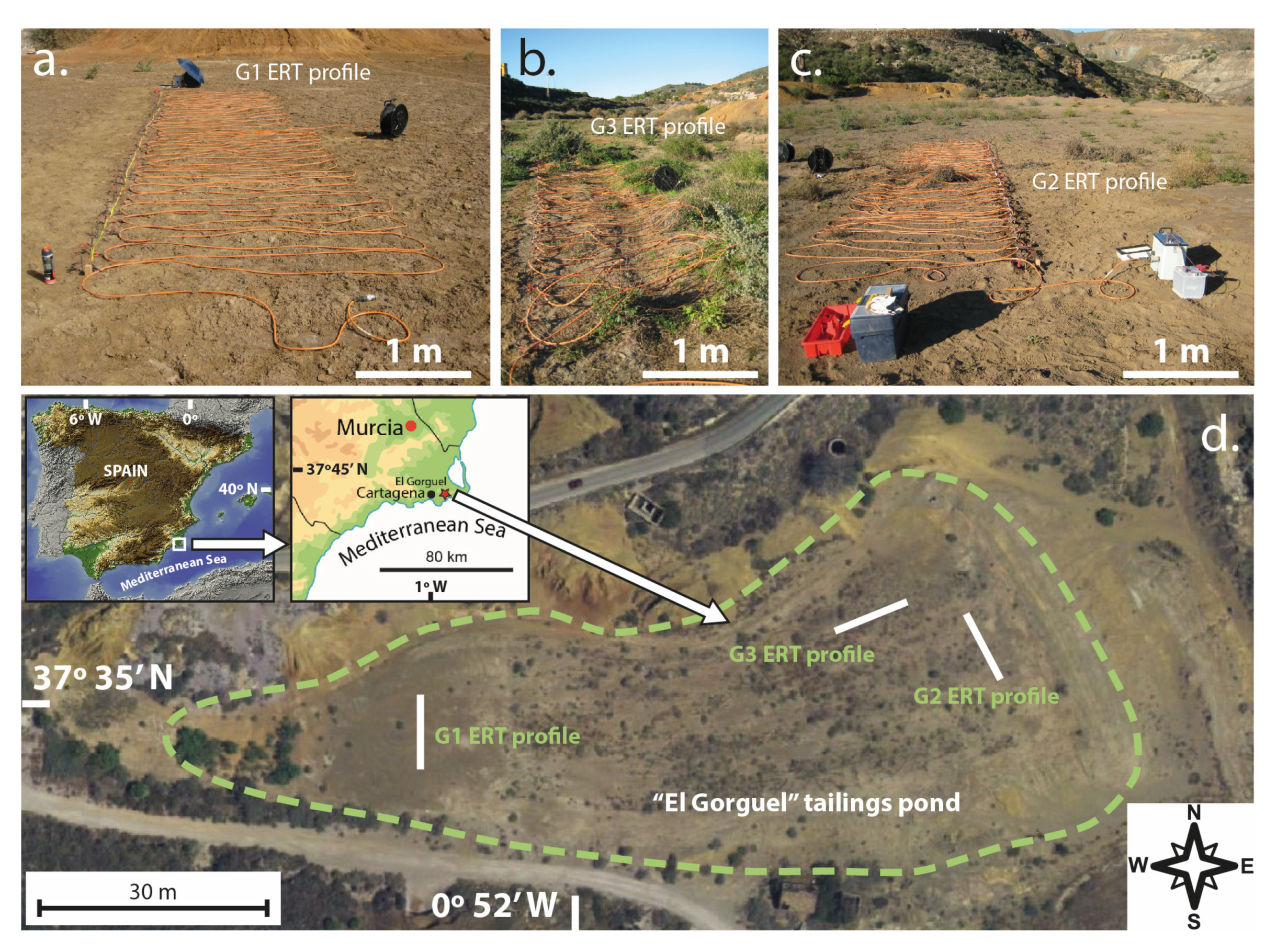

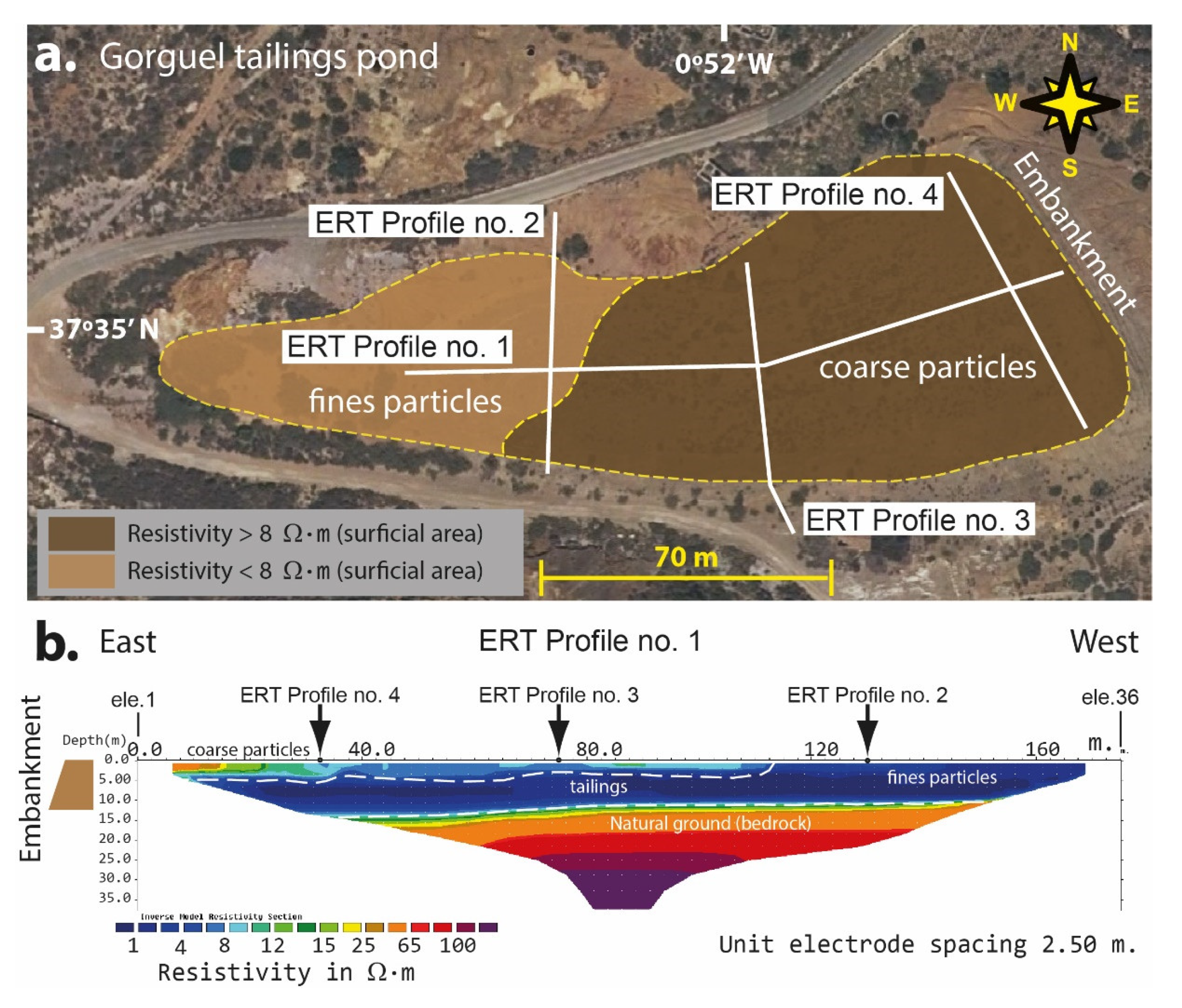
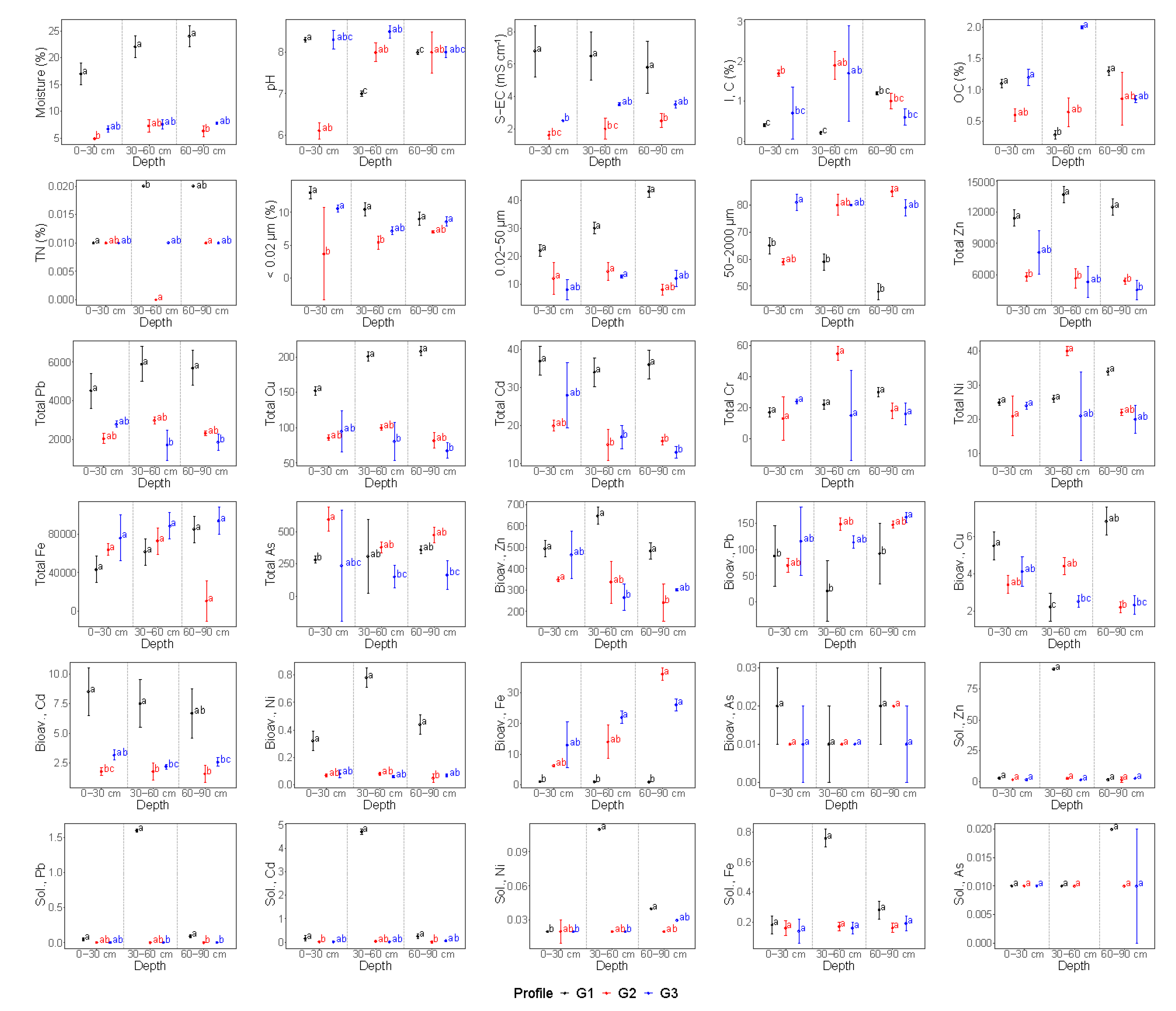
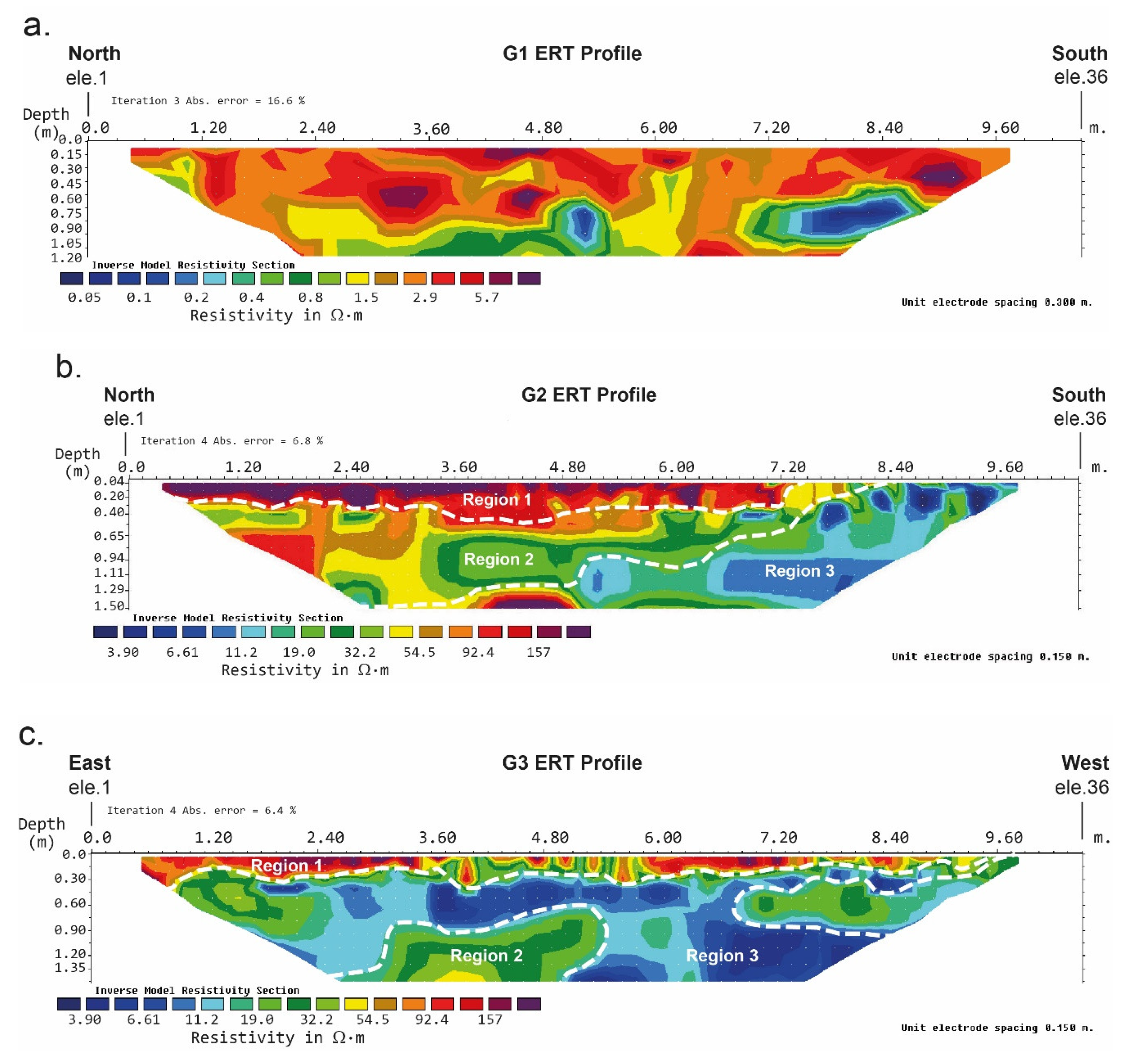

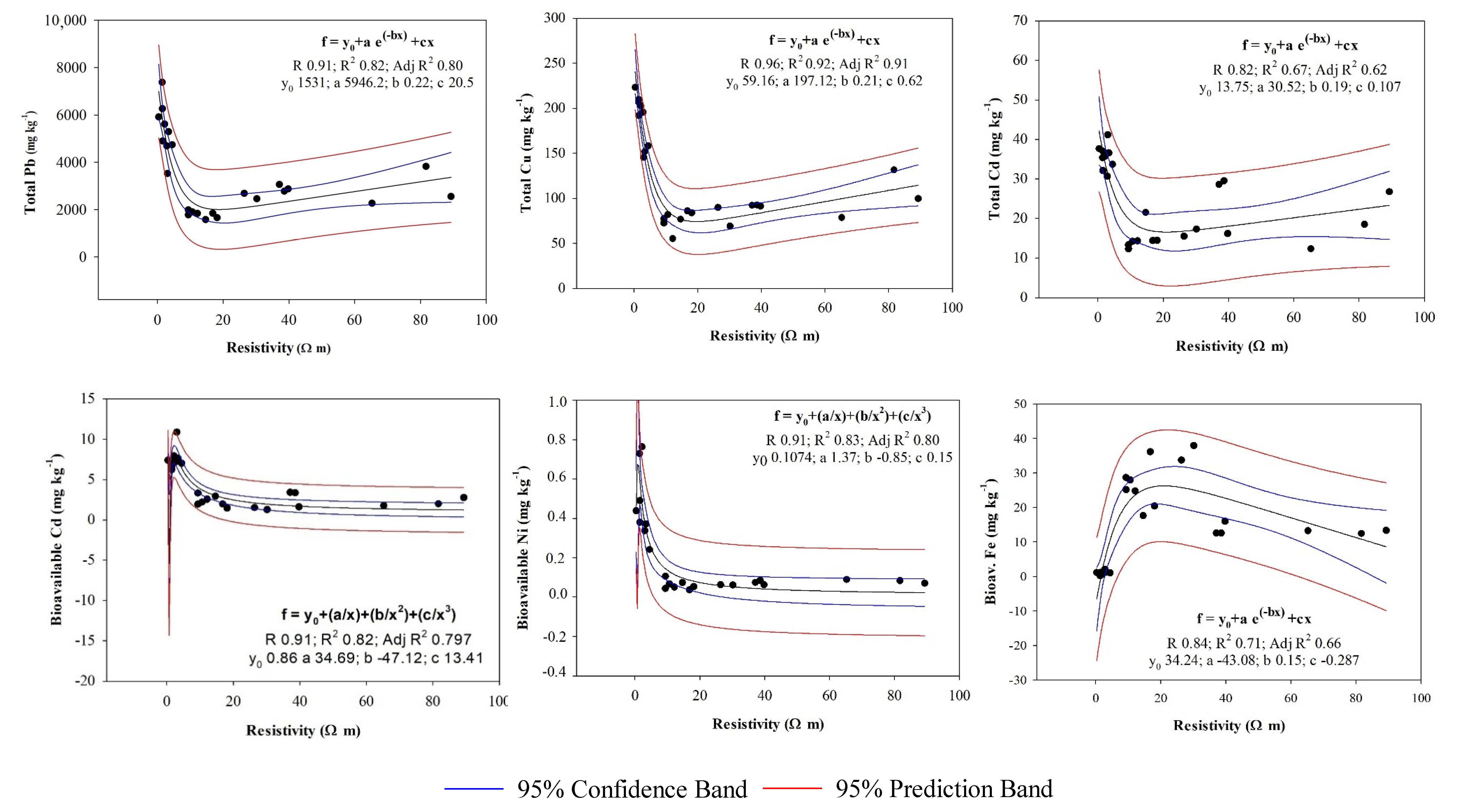
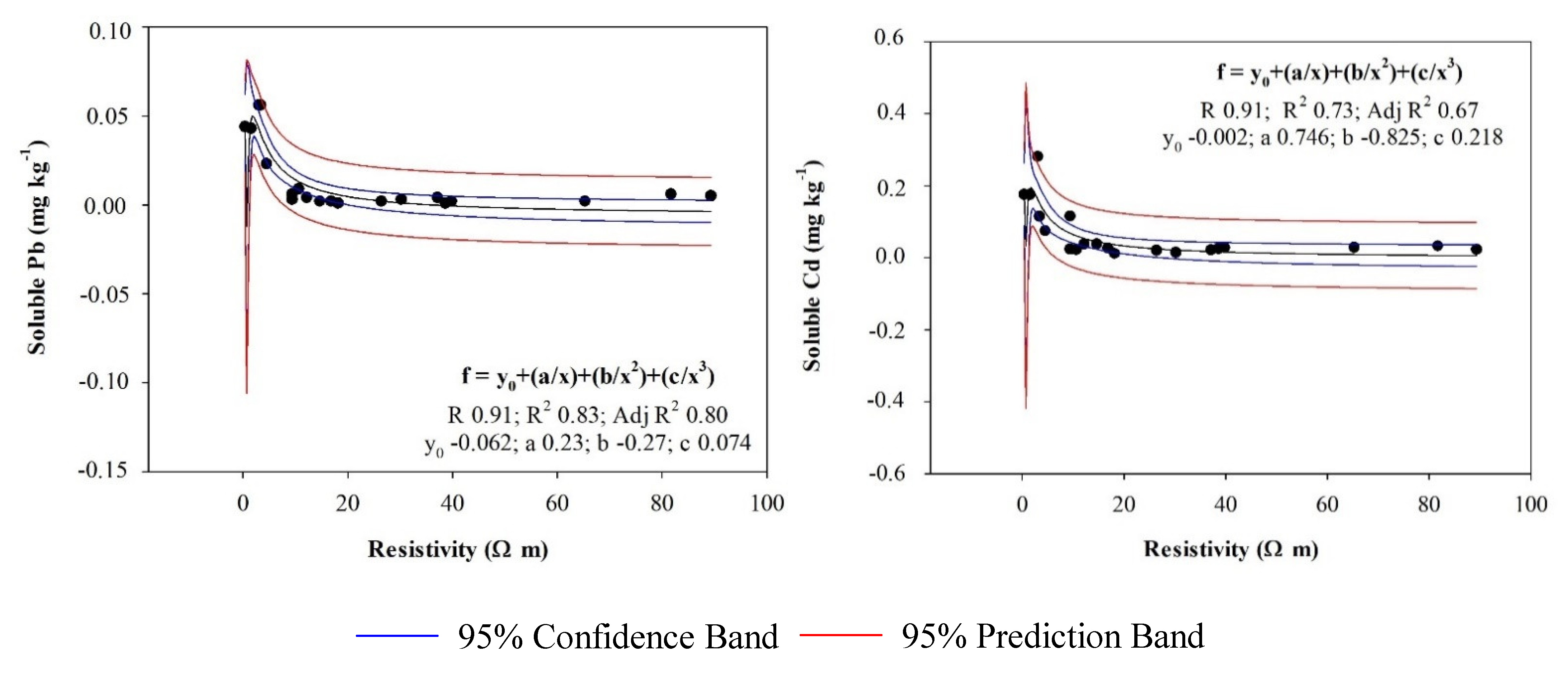
© 2020 by the authors. Licensee MDPI, Basel, Switzerland. This article is an open access article distributed under the terms and conditions of the Creative Commons Attribution (CC BY) license (http://creativecommons.org/licenses/by/4.0/).
Share and Cite
Gabarrón, M.; Martínez-Pagán, P.; Martínez-Segura, M.A.; Bueso, M.C.; Martínez-Martínez, S.; Faz, Á.; Acosta, J.A. Electrical Resistivity Tomography as a Support Tool for Physicochemical Properties Assessment of Near-Surface Waste Materials in a Mining Tailing Pond (El Gorguel, SE Spain). Minerals 2020, 10, 559. https://doi.org/10.3390/min10060559
Gabarrón M, Martínez-Pagán P, Martínez-Segura MA, Bueso MC, Martínez-Martínez S, Faz Á, Acosta JA. Electrical Resistivity Tomography as a Support Tool for Physicochemical Properties Assessment of Near-Surface Waste Materials in a Mining Tailing Pond (El Gorguel, SE Spain). Minerals. 2020; 10(6):559. https://doi.org/10.3390/min10060559
Chicago/Turabian StyleGabarrón, María, Pedro Martínez-Pagán, Marcos A. Martínez-Segura, María C. Bueso, Silvia Martínez-Martínez, Ángel Faz, and José A. Acosta. 2020. "Electrical Resistivity Tomography as a Support Tool for Physicochemical Properties Assessment of Near-Surface Waste Materials in a Mining Tailing Pond (El Gorguel, SE Spain)" Minerals 10, no. 6: 559. https://doi.org/10.3390/min10060559
APA StyleGabarrón, M., Martínez-Pagán, P., Martínez-Segura, M. A., Bueso, M. C., Martínez-Martínez, S., Faz, Á., & Acosta, J. A. (2020). Electrical Resistivity Tomography as a Support Tool for Physicochemical Properties Assessment of Near-Surface Waste Materials in a Mining Tailing Pond (El Gorguel, SE Spain). Minerals, 10(6), 559. https://doi.org/10.3390/min10060559








